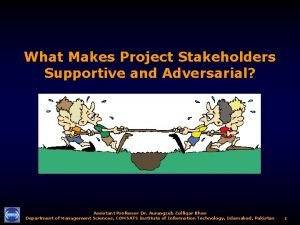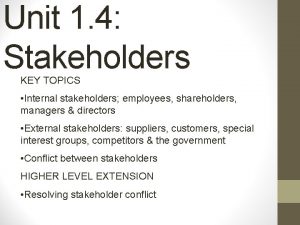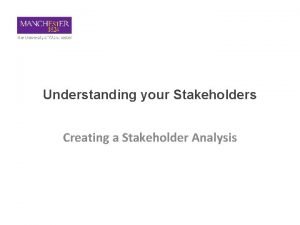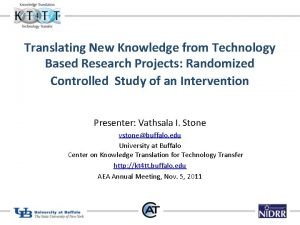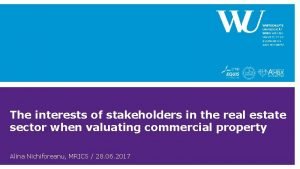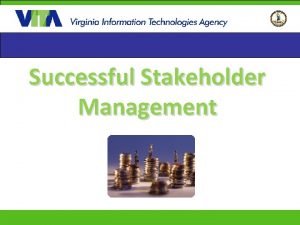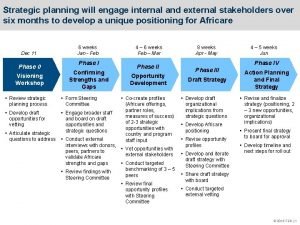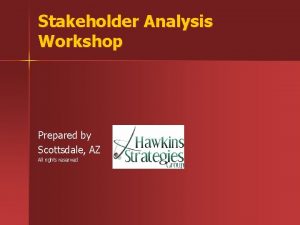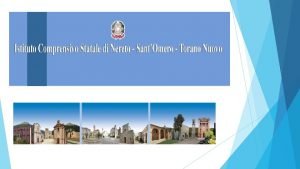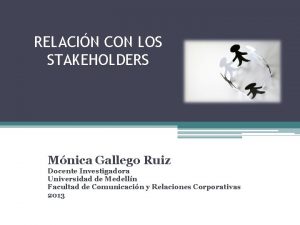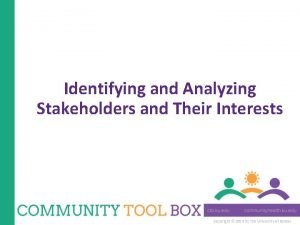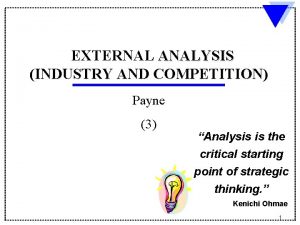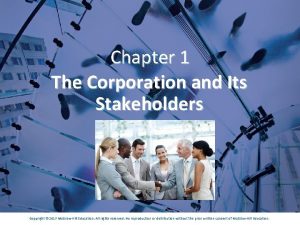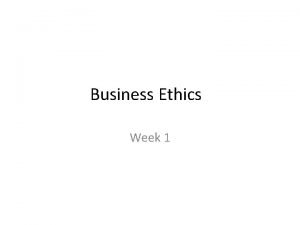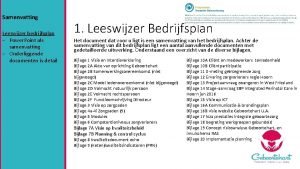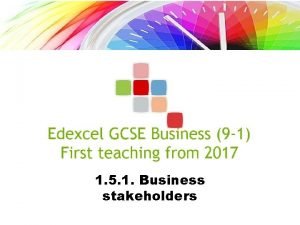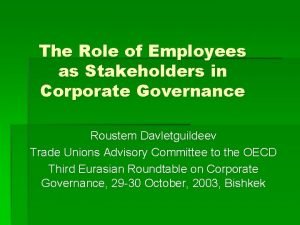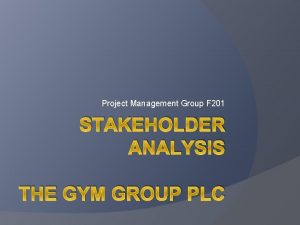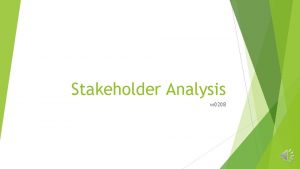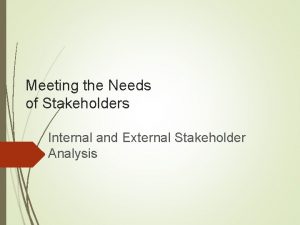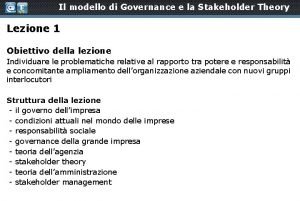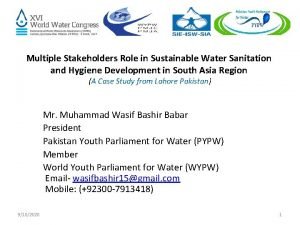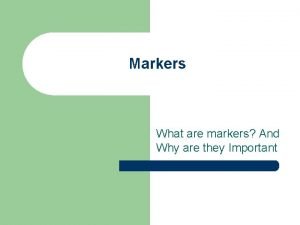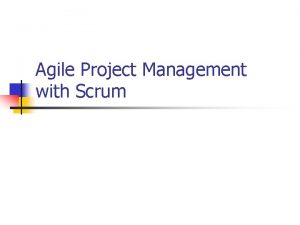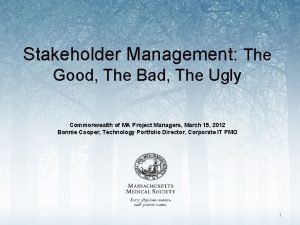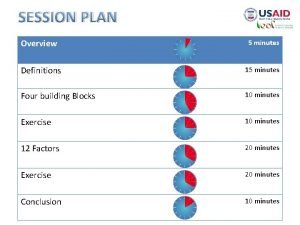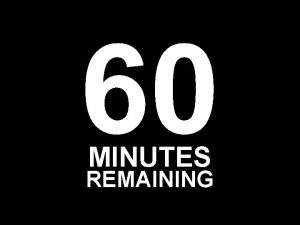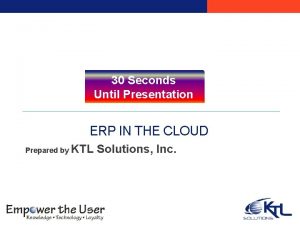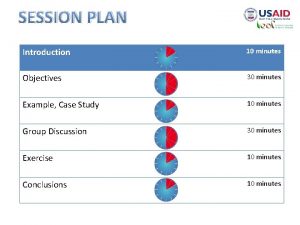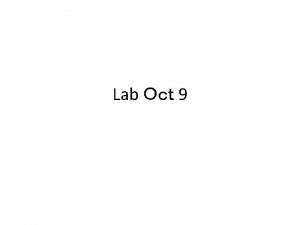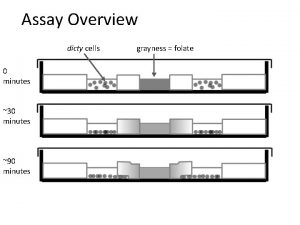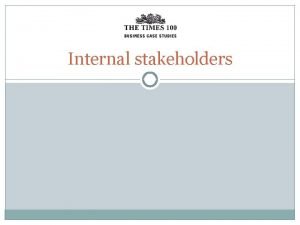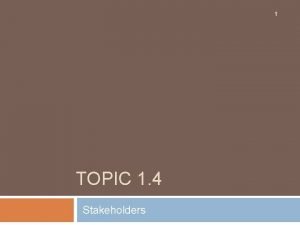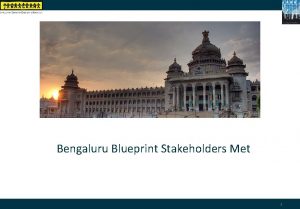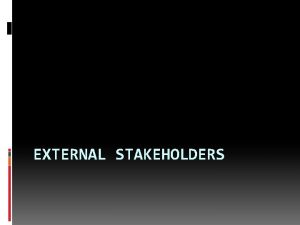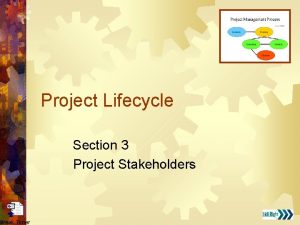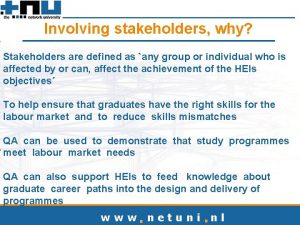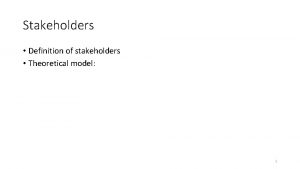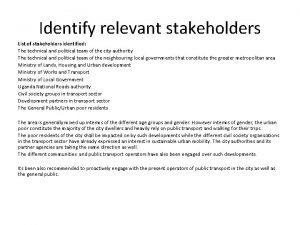SESSION PLAN Overview 10 minutes Stakeholders identification 10










































- Slides: 42

SESSION PLAN Overview 10 minutes Stakeholders identification 10 minutes Exercise/Role play 20 minutes Methods and Tools for Analysis stakeholders (4 Rs) 20 minutes Exercise 20 minutes Stakeholder participation 5 minutes Conclusion 5 minutes

Low Emissions Land Use Planning Development Team Acknowledgements Name Affiliation David Saah; Co-Lead University of San Francisco, SIG Name Affiliation Phan Xuan Thieu Vinh University, Vietnam Mohd Zaki Hamzah; Co-Lead University Putra Malaysia Chalita Sriladda USAID-LEAD Khamla Phanvilay, Co-Lead National University of Laos Hoang Thi Thu Duyen Vietnam Forestry University, Vietnam Cao Thuy Anh Dalat University, Vietnam Ladawan Puangchit Kasetsart University, Thailand Chalermpol Samranpong Chiang Mai University, Thailand Do Anh Tuan Vietnam Forestry University, Vietnam Pham Thanh Nam USAID LEAF Vietnam Lyna Khan Royal University of Phnom Penh, Cambodia Peter Stephen USAID LEAF Bangkok Le Ba Thuong Vietnam Forestry University, Vietnam Hoang Vinh Phu Vinh University, Vietnam Napat Jakwattana University of Phayao, Thailand Vipak Jintana Kasetsart University, Thailand Nur Anishah Binti Aziz University Kebangsaan Malaysia Kulala Mulung PNG University of Technology Ratcha Chaichana Kasetsart University, Thailand Sureerat Lakanavichian Chiang Mai University, Thailand Somvilay Chanthalounnavong National University of Laos Thavrak Huon Royal University of Agriculture, Cambodia Vongphet Sihapanya National University of Laos Athsaphangthong Munelith USAID LEAF Laos David Ganz USAID LEAF Bangkok Attachai Jintrawet Chiang Mai University, Thailand Chi Pham, Project Coordinator USAID LEAF Bangkok Chanin Chiumkanokchai USAID LEAF Bangkok Kent Elliott US Forest Service Lam Ngoc Tuan Dalat University, Vietnam Beth Lebow US Forest Service Mark Fenn USAID Vietnam Forests & Deltas Geoffrey Blate US Forest Service

Low Emission Land Use Planning (LELUP) Section 1. Enabling Environment 1. 2. Stakeholder Engagement Regional Climate Change Curriculum Development

LELUP Framework 5. 3. Evaluate, Report & Adapt 1. 1. Regulatory Assessments 5. 2. Monitor & Measure Progress 1. 2. Stakeholder Engagement 1. 3. Planning & Development Goals & Objectives 5. 1. Establish M&E Framework MONITORING & EVALUATION 4. 3. Implementation Needs NEGOTIATING & PRIORITIZING IMPLEMENTATION PLAN 4. 2. Priorities & Sequence Implementation Activities ENABLING ENVIRONMENT Low Emission Land Use Planning ASSESSMENT OF CURRENT CONDITION ANALYSIS OF FUTURE OPTIONS 4. 1. Negotiating Agreement on Options 3. 3. Scenario Assessment 2. 1. Environment, Social, & Economic Data Needs 2. 2. Understanding Historic Land Use Change 2. 3. Data & Capacity Gap Assessment 3. 1. Modeling Future Trends 3. 2. Business as Usual Baseline Construction

Learning Objectives At the end of this session, learners will be able to: § Associate processes that help to identify all stakeholders that need to be involved in the planning process or impacted (+ and 1) by the plan. § Identify vulnerable groups at risk from the implementation of a plan and possible mitigation strategies to avoid.

Session Outline § Stakeholders; § Stakeholder analysis; § Power; and § Participation.

What is a Stakeholder? A Stakeholder is : “…An individual, group or institution that has an interest in a particular forest resource …” (RECOFTC 2002) “…groups/individuals that are affected by the outcome of a conflict, as well as those who influence the outcome…” (FAO 2005)

Stakeholders Primary Stakeholders: “…are those most affected by and are dependent on the resources…” Secondary Stakeholders : “…are those who are more indirectly or less affected or dependant on the resources…” (FAO 2005)

Stakeholders Core issue of policy

Who could be a stakeholder for a Low Emission Land Use Plan? Increased production What are our boundaries? resource claims Increased consumption Who are we working with? More Growing food demand Growing population More competition What are we trying to achieve? What are the ‘rules’ to achieve this? Climate change

What Is At Stake? A “stake” can be: § particular forest product § particular forest service § particular interests

Who Are Stakeholders? § Government oversight of actions § Universities, scientists or NGO leaders § Beneficiaries of goods and services derived from the implementation of the plan

Land Use Planning Case Study Stakeholders (Lam Dong Province, VN ) National § MARD § MONRE § VN Forest Provincial § DARD § DONRE § Dalat University District/Commune § Bao Lam SFC § Local Communities

Land Use Planning Case Study Stakeholders (Lam Dong Province, VN ) Provincial District & Commune

Why do a Stakeholder Analysis?

Exercise Why encourage stakeholder participation in a Low Emission Land Use Plan?

A Stakeholder Analysis allows you § To identify and define key stakeholders § To identify who needs to participate in the project § To assess how they might affect or be affected by REDD+ interventions (positively or negatively)

A Stakeholder Analysis allows you § To identify the multiple interests and objectives of stakeholders in relation to the particular REDD+ project § To understand the actual resources, influence, authority or power that stakeholders can bring to bear on particular REDD+ initiatives

A Stakeholder Analysis allows you § To assess the most appropriate means for them to participate § To assess the capacity of stakeholders to participate in the planning process § To begin to understand potential stakeholder conflicts that could arise in REDD

Steps in SA 1. Identify Issues and clarify objective 2. Identify stakeholders Questions & Tools -What problem that need to address? -The objective & intended outputs of project Tools: problem tree and objective tree (seen in SES) -Who are primary, secondary, and has interest in the issue? -Tool: Stakeholder rings (as above) 3. Investigate characteristics of stakeholder -What are the interest, 4 RS (Rights, Responsibilities, Returns, and Relationship) -Tools: Stakeholder interests, and 4 R matrix, Venn-Diagram , and Matrix of conflict & trade -off 4. Identify power and influence of stakeholders -What are the power and influence of each stakeholder - Tools: Graph of stakeholders importance and influence

4 R Stakeholder Analysis Matrix WHAT IS THE 4 R STAKEHOLDER ANALYSIS MATRIX? RIGHTS RESPONSIBILITIES RETURNS (OR BENEFITS) RELATIONSHIPS

4 R Stakeholder Analysis Matrix Stakeholder Interests (an example of a case in communal forest management of FUGs in VN) Stakeholder group Interests Relative important of interest FUG members Improved income & fuel wood use Medium Other households Water reserve & fuel wood/ or not in FUGs income Low Vil. Mgt. committee Contract fees & Local responsibility Medium Dist. Forest Protection Department Institutional responsibility + fee receiving Low Agr. & For. Extension Techniques supports Medium

4 R Stakeholder Analysis Matrix Rights § Access to and use of resources (statutory and customary) § Ownership of resources (statutory and customary) § Decision-making over resource use and management (e. g. setting by-laws, enforcement/fines, zoning/exclusion, licensing/income, etc. )

4 R Stakeholder Analysis Matrix Responsibilities § Forest/resource management (planning, monitoring, measurement, etc. ) § Implementing decisions in rules, regulations, procedures, etc. § Abiding by rules & regulations

4 R Stakeholder Analysis Matrix Returns (or benefits) § Direct benefits arising from forest resources accessed § Direct benefits derived from employment related to the resource/area § Indirect benefits such as those accruing to entire community from resource management agreements

4 R Stakeholder Analysis Matrix Relationships § Inter-relationships among stakeholders within the community or outside of the community § Conflict among stakeholders

4 R Stakeholder Analysis Matrix Pattern of interaction among stakeholders ● Venn diagram Example: Venn diagram of actors involving in communal forest management at Cai village, Hoa Binh province, Vietnam Dis. rangers CPC Social gr. Vil. Mgt. committee Social gr. Village FUGs Security Com. forests Outsiders (-)

Group Activity § Read the Case study on a REDD+ project in Kalimantan, Indonesia (KFCP) and watch the video at http: //vimeo. com/16239538 § Break out in small groups and using the 4 R Stakeholder Analysis Matrix , fill up the template on the 4 Rs(rights, responsibilities, relationships, returns ) § Make sure you consider the following questions:

Exercise: The 4 R Stakeholder Analysis Matrix Stakeholders Stakeholder A Stakeholder B Stakeholder C Rights Responsibility Relationship Returns

What is Power? The ability to get what one wants This can occur through: § Force (sometimes referred to as “power over”) § Cooperation (referred to as “power with” or exchange power)

Sources of Power Resource control Alliances/ Connections Coercion Power Legitimate Expert Charm/ Charisma Information

Importance Power and Influence Group 1: High Importance / Low Influence Group 2: High Importance / High Influence Group 3: Low Importance / Low Influence Group 4: Low Importance / High Influence

Power and Influence

Identifying and Analysing Stakeholders Key Points § It is an iterative process and not a one-off as new stakeholders come into the § Can be done in an participatory manner § Requires building trust and fostering communication and collaboration § Legitimate stakeholders?

Class Exercise Can there be illegitimated stakeholders? Illegal Foresters… Poachers… Corrupt Government Officials…

Stakeholder Participation Discuss with a partner what your understanding of “PARTICIPATION” is in the context of low emission land use planning.

The Participation Continuum : In what ways and at What Levels there can be participated

Stakeholder Participation Key Points § Different level of participation requires different approaches § Certain attributes encourage participation in Low Emission Land Use Planning § Level of participation is influenced by certain factors § Core Values for Participatory Process under pin stakeholder participation at all levels of engagement

Common Challenges For LELUP § Ignoring or simply forgetting about stakeholders. § Broad and vague analysis of stakeholder’s commonly masks important differences. § As Low Emission Forest and Land Use Plans are new, many stakeholders may not have the capacity or knowledge to genuinely contribute to the process.

Emerging Opportunities For LELUP § There is tremendous interest in low emission planning, climate change mitigation options and adaptation opportunities. § This interest and desire to learn should help facilitate a broad and inclusive process.

References: • Multi-Stakeholder Processes Knowledge Co-Creation Portal (hosted by Wageningen University) and the publication Tools for Analysing Power in Multistakeholder Processes - A Menu. Useful tools in this publication include: ‘Importance against Influence Matrix’, ‘Stakeholder Characteristics and Roles Matrix’, ‘Spider Web Network Diagram’ and ‘Net-Map’. • Power Tools: For Policy Influence in Natural Resource Management (produced by IIED). Useful tools include: ‘Stakeholder Influence Mapping’, ‘Stakeholder Power Analysis’ and ‘The Four Rs’. • Gendered roles and responsibilities in a land use planning process are also essential considerations that will have important and long-term impacts in the equitable and sustainable implementation of any agreed plan. The LEAF project has published it’s Gender Mainstreaming Strategy and Checklist that provides useful guidance on this issue.

References: § Negotiation and Mediation in Natural Resource Management , FAO 2005 § The Art of Facilitation Capacities : A Training Manual – Lydia Braakman + Karen Edwards ( RECOFTC 2002) , Pg. 38 - 47 and 195 § Climate Change, REDD+ + Indigenous Peoples : Training Course for Indigenous People, TEBTEBBA, 2010 § What is REDD+ ? A Guide for Indigenous Communities, AIIP , 3 rd Edition 2012 § REDD- Net Website § Friends of the Earth Website § Participatory Management of Forests and PAs: A Trainers Manual, RECOFTC, 2008 § Video: Not for Sale : The Fantasy of Carbon Offsetting
 1hr to sec
1hr to sec Lac session on ict
Lac session on ict Positive identification
Positive identification Example of session plan
Example of session plan Adversarial stakeholders
Adversarial stakeholders Primary and secondary stakeholders
Primary and secondary stakeholders Internal stakeholders
Internal stakeholders Understanding your stakeholders
Understanding your stakeholders C level stakeholders
C level stakeholders Real estate stakeholders
Real estate stakeholders Power and influence matrix
Power and influence matrix Internal vs external stakeholders
Internal vs external stakeholders Managers interest in a business
Managers interest in a business Stakeholders in business
Stakeholders in business Bank stakeholders analysis
Bank stakeholders analysis How to write background of the project
How to write background of the project Stakeholders scuola
Stakeholders scuola Stakeholders
Stakeholders Stakeholders scuola
Stakeholders scuola Stakeholders and their interests
Stakeholders and their interests Examples of internal stakeholders
Examples of internal stakeholders Primary secondary stakeholders
Primary secondary stakeholders Stakeholder approach
Stakeholder approach Interactive social system
Interactive social system Primary and secondary stakeholders
Primary and secondary stakeholders Ford motor company stakeholders
Ford motor company stakeholders Interne stakeholders
Interne stakeholders Stakeholder gcse business
Stakeholder gcse business Secondary stakeholders
Secondary stakeholders Role of employees as stakeholders
Role of employees as stakeholders Stakeholders in hiv prevention
Stakeholders in hiv prevention Stakeholders de un gimnasio
Stakeholders de un gimnasio Onion model of stakeholders
Onion model of stakeholders Stakeholder internal and external
Stakeholder internal and external Teoria degli stakeholder
Teoria degli stakeholder Stakeholders in water and sanitation
Stakeholders in water and sanitation Stakeholders plural marker
Stakeholders plural marker Invitation to stakeholders meeting
Invitation to stakeholders meeting Ibm stakeholders
Ibm stakeholders At the seventh sprint review the stakeholders
At the seventh sprint review the stakeholders Parenzo invest
Parenzo invest Www-sena-edu-co
Www-sena-edu-co Poor stakeholder management
Poor stakeholder management




